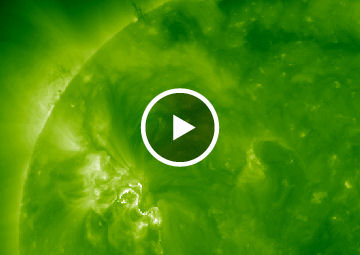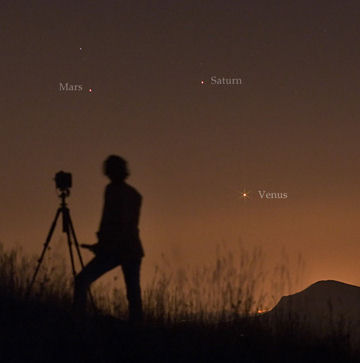iPHONE VS ANDROID! Actually, it doesn't matter which phone you carry. Our cool, new app turns both smartphones into field-tested satellite trackers. Learn more. | | | PERSEID METEOR UPDATE: "The Perseids are still booming here in Alabama," reports astronomer Bill Cooke of the Marshall Space Flight Center. "Although the peak of the shower is days away, we saw four Perseid fireballs last night (Aug. 7-8). It's a good sign that this year's shower will be a good one." [live meteor radar] [2009 Perseid gallery] [2010 meteor counts] SOLAR BLAST JUST MISSES EARTH: On August 7th (1825 UT), magnetic fields around sunspot 1093 became unstable and erupted, producing a strong M1-class solar flare. Several amateur astronomers caught the active region in mid-flare, while NASA's Solar Dynamics Observatory recorded an extreme ultraviolet movie of the entire event: 
Note: A close-up movie is also available.
The eruption hurled a coronal mass ejection (CME) into space, just missing a direct sun-Earth line. Forecasters expect the cloud to deliver no more than a glancing blow to our planet's magnetic field when it billows by on August 9th or 10th--not be a major space weather event. Future eruptions could turn out differently. Active region 1093 is rotating toward Earth. By the end of this weekend, we'll be in the line of fire if its magnetic fields become unstable again. Space Weather Phone subscribers will be the first to know. EXTRA! SOLAR RADIO BURSTS: The flare produced intense radio bursts detectable by ordinary shortwave receivers on Earth. In New Mexico, amateur radio astronomer Thomas Ashcraft picked up strong emissions around 21 MHz. "Listen to some of the sounds than came out of the loudspeakers," he says. "This was a complex flare and very exciting. Yet it is still small stuff compared to what is coming in the future as Solar Cycle 24 intensifies." SUNSET PLANETS: When the sun goes down tonight, step outside and look west. You might see something like this: 
Babak Tafreshi sends the picture from the Alborz Mountains of Iran. "Venus, Saturn and Mars are in triple conjunction," says Tafreshi, "and they will be at their most beautiful in the nights ahead." Next week, on August 12th, the trio will become a quartet when the crescent Moon joins the planets for an amazing four-way conjunction. Even more amazing, it happens on the peak-night of the Perseid meteor shower. Astronomy doesn't get much better than this! sky maps: August 8, 9, 10, 11, 12, 13 more images: from Richard Glenn of Gold Beach, Oregon; from Tom Wagner of Waterloo, Iowa; from Giuseppe Pappa of Mascalucia, Sicily, Italy;
August 2010 Northern Lights Gallery
[previous Augusts: 2009, 2008, 2007, 2006, 2005, 2004, 2003]
Solar Eclipse Photo Gallery
[NASA: South Pacific Eclipse] [animated map] | 
